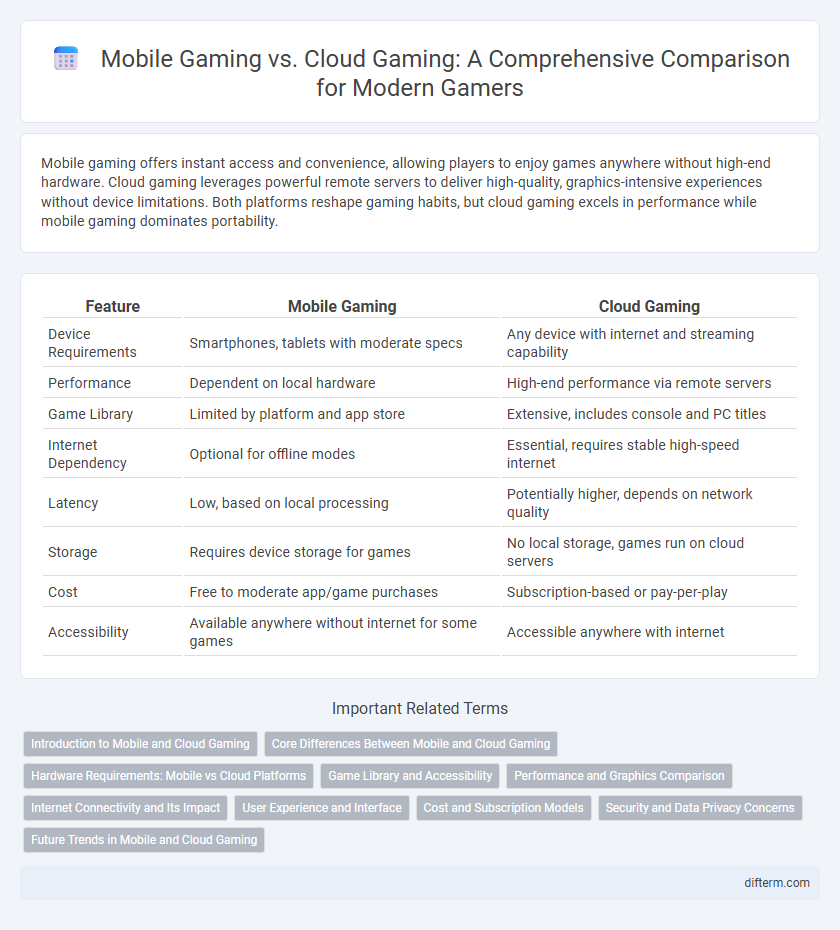Mobile gaming offers instant access and convenience, allowing players to enjoy games anywhere without high-end hardware. Cloud gaming leverages powerful remote servers to deliver high-quality, graphics-intensive experiences without device limitations. Both platforms reshape gaming habits, but cloud gaming excels in performance while mobile gaming dominates portability.
Table of Comparison
| Feature | Mobile Gaming | Cloud Gaming |
|---|---|---|
| Device Requirements | Smartphones, tablets with moderate specs | Any device with internet and streaming capability |
| Performance | Dependent on local hardware | High-end performance via remote servers |
| Game Library | Limited by platform and app store | Extensive, includes console and PC titles |
| Internet Dependency | Optional for offline modes | Essential, requires stable high-speed internet |
| Latency | Low, based on local processing | Potentially higher, depends on network quality |
| Storage | Requires device storage for games | No local storage, games run on cloud servers |
| Cost | Free to moderate app/game purchases | Subscription-based or pay-per-play |
| Accessibility | Available anywhere without internet for some games | Accessible anywhere with internet |
Introduction to Mobile and Cloud Gaming
Mobile gaming utilizes smartphones and tablets, offering portable access to a diverse range of games with optimized touch controls and offline play options. Cloud gaming streams games directly from remote servers, requiring minimal hardware while providing instant access to high-quality graphics and multiplayer experiences. Both platforms represent distinct advancements in gaming technology, catering to different user preferences and connectivity capabilities.
Core Differences Between Mobile and Cloud Gaming
Mobile gaming relies on local hardware such as smartphones and tablets, offering offline accessibility and instant play without internet dependency. Cloud gaming streams games from remote servers, requiring high-speed internet but enabling access to high-quality titles on low-end devices without substantial downloads. Key differences include hardware dependence, gameplay latency, and storage requirements, with cloud gaming emphasizing streaming technology and mobile gaming prioritizing device portability.
Hardware Requirements: Mobile vs Cloud Platforms
Mobile gaming requires smartphones with advanced GPUs, sufficient RAM, and high-refresh-rate displays for optimal performance, while cloud gaming demands minimal hardware, relying instead on stable high-speed internet connections and remote servers to handle processing power. Mobile platforms must balance battery life and thermal constraints, whereas cloud gaming shifts computational load away from the device, enabling gameplay on lower-spec hardware like basic smartphones or smart TVs. Network latency and bandwidth are critical factors in cloud gaming, contrasting with the local processing emphasis in mobile gaming hardware requirements.
Game Library and Accessibility
Mobile gaming offers a vast and diverse game library accessible directly through smartphones and tablets, enabling players to enjoy titles anywhere without additional hardware. Cloud gaming provides instant access to high-quality AAA games from extensive libraries on multiple devices, eliminating the need for downloads or powerful local hardware. Both platforms emphasize accessibility, but mobile gaming excels in offline play while cloud gaming leverages internet connectivity for seamless streaming of premium content.
Performance and Graphics Comparison
Mobile gaming often delivers smoother performance on optimized devices but is constrained by hardware limitations affecting graphics quality and frame rates. Cloud gaming leverages powerful remote servers to stream high-resolution graphics with consistent performance, reducing local device dependency. Latency and internet speed remain critical factors influencing gameplay responsiveness and overall experience in cloud gaming compared to native mobile gaming.
Internet Connectivity and Its Impact
Mobile gaming relies heavily on stable internet connections for downloading updates and accessing multiplayer features, though many games offer offline modes. Cloud gaming demands consistently high-speed, low-latency internet to stream games seamlessly from remote servers, with connection quality directly impacting gameplay experience. Poor internet connectivity in cloud gaming leads to buffering, input lag, and reduced graphics quality, making it less suitable in areas with unreliable networks compared to mobile gaming.
User Experience and Interface
Mobile gaming offers intuitive touch controls and portability, allowing users to play anywhere with responsive interfaces tailored for small screens. Cloud gaming provides high-quality graphics and seamless gameplay on various devices without hardware limitations, but relies heavily on stable internet connectivity to maintain smooth user experience. Both formats prioritize user-friendly designs, yet mobile gaming excels in accessibility while cloud gaming focuses on performance and graphical fidelity.
Cost and Subscription Models
Mobile gaming typically requires a one-time purchase or free-to-play model with in-app purchases, making it more cost-effective for casual players. Cloud gaming relies on subscription models, such as Xbox Cloud Gaming or NVIDIA GeForce Now, which can incur ongoing monthly fees but offer access to extensive game libraries without expensive hardware. Cost considerations often hinge on play frequency and hardware investment, with cloud gaming appealing to users seeking variety and mobile gaming favoring budget-conscious gamers.
Security and Data Privacy Concerns
Mobile gaming often faces security vulnerabilities due to device susceptibility to malware and unauthorized app access, raising significant data privacy concerns. Cloud gaming centralizes data storage on remote servers, which can offer enhanced security protocols but also introduces risks related to data breaches and third-party access. Players must evaluate encryption standards, authentication methods, and data handling practices to safeguard personal information across both gaming platforms.
Future Trends in Mobile and Cloud Gaming
Mobile gaming is rapidly advancing with 5G integration and AI-driven personalization, enabling richer, low-latency experiences on handheld devices. Cloud gaming leverages edge computing and expansive server networks to offer seamless, high-fidelity gameplay across diverse platforms without hardware limitations. Emerging trends indicate a convergence where cloud infrastructures will enhance mobile gaming performance, driving widespread adoption and innovation in immersive, cross-platform entertainment.
Mobile Gaming vs Cloud Gaming Infographic

 difterm.com
difterm.com